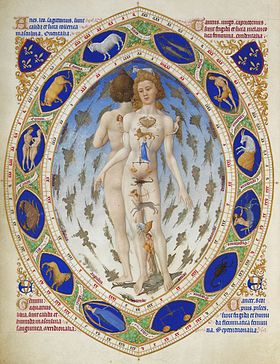Zodiac


The zodiac (from Latin/Greek Zodiakos/ζῳδιακός) comprises a zone about 20° wide around the apparent orbit of the Sun, the ecliptic, within which the movements of the Moon and the planets visible from Earth pass. Within the zodiac lie the twelve constellations that have given their names to the well-known twelve signs of the zodiac. Twelve cosmic directional forces are thereby established.
From a spiritual point of view, the zodiac is the physical expression of the first hierarchy, in particular the community of the Cherubim and Seraphim, whose dominions extend far beyond the boundaries of our solar system, whereby the Cherubim are to be addressed as the actual zodiacal beings.
The twelve signs of the zodiac
The signs of the zodiac divide the zodiac into 12 sections of exactly the same size, each 30°. At the time of their naming about 2500 years ago, the signs of the zodiac were largely congruent with the corresponding constellations, except for the different sizes of the individual constellations, which are not always exactly 30°. Due to precession, the signs of the zodiac shift in relation to the constellations by one whole sign each in about 2160 years. Only after 25920 years (= 12 x 2160) is the original state restored.
Western astrology, also called tropical astrology, is oriented towards the course of the year and continues to calculate with the original system of the zodiac signs despite the shift in relation to the corresponding constellations. The tropical zodiac begins with the vernal equinox, which is invariably equated with the beginning of the zodiac sign Aries. In fact, however, the vernal equinox today is astronomically already far in the constellation of Pisces. According to Rudolf Steiner, it had entered the constellation of Aries much earlier, namely at the beginning of the Greco-Latin period in 747 BC.
In Indian astrology, the sidereal zodiac is used. Here the signs of the zodiac are firmly bound to the constellations, which is why one speaks of sidereal astrology. In this system, the signs of the zodiac move gradually through all the seasons together with the constellations in the course of precession.
Literature
- Gisela Gorrissen: Astrologie aus anthroposophischer Sicht. Eine Einführung, Urachhaus Vlg., Stuttgart 2000
- Rudolf Steiner: Das Hereinwirken geistiger Wesenheiten in den Menschen, GA 102 (2001) English: rsarchive.org German: pdf pdf(2) html mobi epub archive.org
- Rudolf Steiner: Ägyptische Mythen und Mysterien, GA 106 (1992) English: rsarchive.org German: pdf pdf(2) html mobi epub archive.org
- Rudolf Steiner: Das Rätsel des Menschen. Die geistigen Hintergründe der menschlichen Geschichte, GA 170 (1992) English: rsarchive.org German: pdf pdf(2) html mobi epub archive.org
 |
References to the work of Rudolf Steiner follow Rudolf Steiner's Collected Works (CW or GA), Rudolf Steiner Verlag, Dornach/Switzerland, unless otherwise stated.
Email: verlag@steinerverlag.com URL: www.steinerverlag.com. Index to the Complete Works of Rudolf Steiner - Aelzina Books A complete list by Volume Number and a full list of known English translations you may also find at Rudolf Steiner's Collected Works Rudolf Steiner Archive - The largest online collection of Rudolf Steiner's books, lectures and articles in English. Rudolf Steiner Audio - Recorded and Read by Dale Brunsvold steinerbooks.org - Anthroposophic Press Inc. (USA) Rudolf Steiner Handbook - Christian Karl's proven standard work for orientation in Rudolf Steiner's Collected Works for free download as PDF. |
